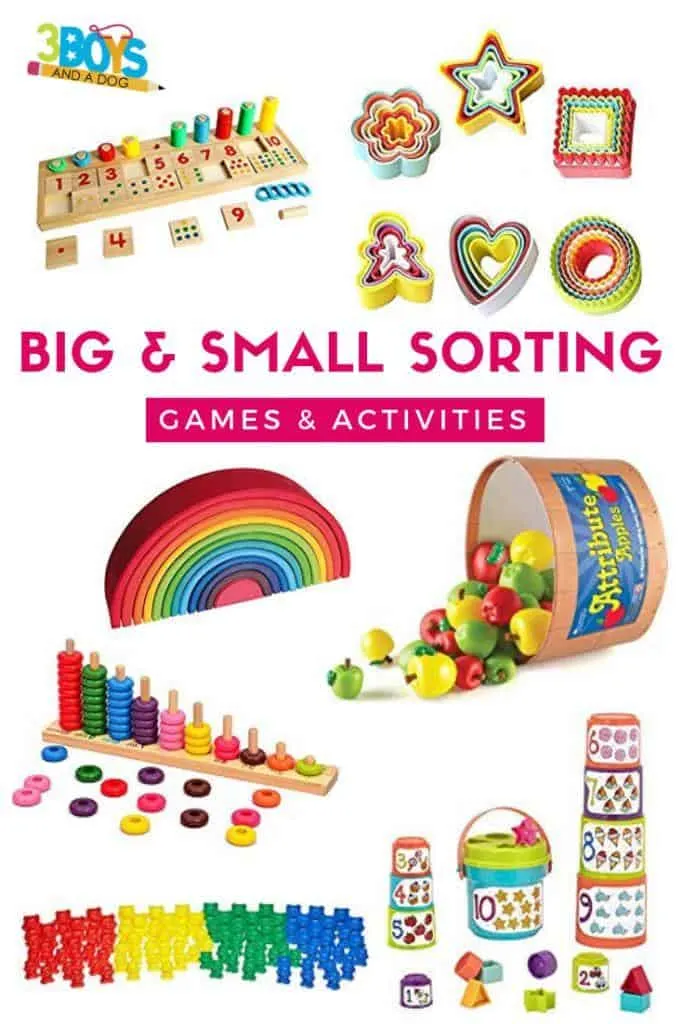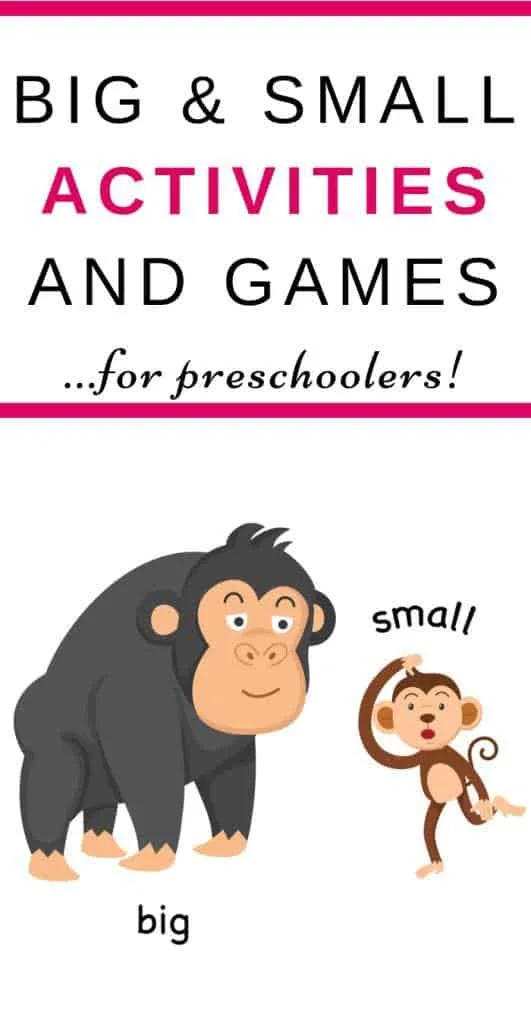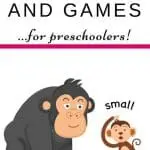These fun toys and activities help your child learn to understand the basics of big and small while engage in fun games and activities.
Grab one of these Big and Small Sorting Activities and Games to help your child learn and understand big and small in a fun hands-on way.

Big and Small Sorting Activities and Games:
When it comes to teaching basic preschool skills, play is the best way to make concepts stick.


Develop pincer and whole hand grasp by picking up, turning, and studying the apples
Sort, classify, and compare apples by 5 attributes including size, color, and physical features (stem, leaf, worm)
Set includes 27 apples and activity guide featuring suggested uses of Venn Diagrams for higher order thinking skills


Perfect shrunken down version of a quintessential Montessori work
A miniature set of Montessori knobbed cylinders.
Most suitable for home teaching of preschool kids, from 1 to 6 years.
A great toy for fine motor skills, spacial reasoning, and hand coordination


Montessori Rainbow Wooden Math Toy Winzik Rings Dominos Preschool Teaching Aids Counting and Stacking Board for kids Children.
One of the reviews says:
Great quality and great design for learning. Using the rings for physical counting with the domino like pieces for visual grouping and the number tor representation of the amount…excellent tool for teaching math and counting


This School Specialty set of teddy bear counters are for use as a math manipulative for preschool to early childhood classrooms. The bears can help children learn to count with understanding, compare quantities in a set, create and extend patterns, sort, or classify. This set of manipulative counters are allergen-free and come in a set of 96, in three sizes and four colors: green, blue, red, and yellow.


32 Pieces Cookie Cutter Set, Multi-size Plastic Biscuit Cutters, Colorful Sandwich Fondant Cake Fruit Vegetable Shapes Cutter


Children place these charming objects on the appropriate mats to practice size discrimination, then match labels with the mats. Includes 30 objects (10 each of 3 sizes), mats, eight labels in English and Spanish, storage basket, and teaching notes. You could even use your own objects (or make the cookies from above) for your child to sort onto the mats.


Sort & Stack Nesting Cups – Educational Stacking Cups with Numbers & Shape Sorting – Water & Sand Play with 19 colorful pieces. Encourage early learning with one of the best nesting toys; teaching colors, numbers, hand-eye coordination and more. In addition to being one of the greatest Big and Small Sorting Activities and Games, it is also great for improving fine motor skills!
Age limit: recommended for ages 18 months +


Balance these brightly colored and playfully tilted blocks to make towers of fun! Sturdy and lightweight, these 10 vibrant blocks can be arranged in endless combinations for hours of building fun.


This unique nesting doll set includes 6 different plastic penguin nesting dolls. Packaging displays a history of the “Matryoshka” or nesting doll craft and interesting Penguin Facts.


The bold colors of this beautifully handmade wooden rainbow will fire your child’s imagination and creativity, and provide hours of open-ended play. This amazing Waldorf-inspired multi-use toy for toddlers, kids and adults is Grimm’s the largest rainbow, measuring over 14 inches long, with 12 colorful pieces. This wonderfully simple, yet versatile design has endless possibilities.
Children will learn about colors, refine hand-eye coordination and motor skills, as well as expand their creative abilities, while being immersed in critical thinking and deep play. Stacking, nesting and building stimulates reasoning skills, essential problem solving activities for children.



Set up with 55 pcs stacking ring puzzles of ten columns + one double-sided wooden basic;Made of high quality solid wood painted with eco-friendly water paint;Makes it so much easier to teach the kids addition and subtraction
More Big and Small Resources:
Because you can’t just give your preschooler a couple Big and Small Sorting Activities and Games and expect them to learn and fully understand the concept of big and small, here are some teaching resources to help further educate your children on this important concept!
Big and Small Preschool Activities for Kids


Ann
Saturday 13th of October 2018
Important preschool skills. Thank you for sharing at Party In Your PJs!
Keitha
Saturday 13th of October 2018
Great collection of activities for sorting.
Julia Robert
Sunday 7th of October 2018
Playing with sorting and stacking toys is best for kids to learn something new. Those old stacking rings are great for this. Browse the widget above for some other toys that will help your child learn more about sizes.